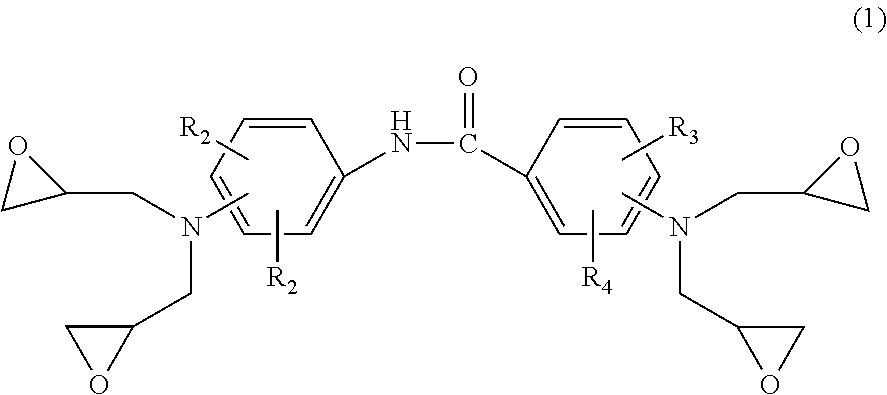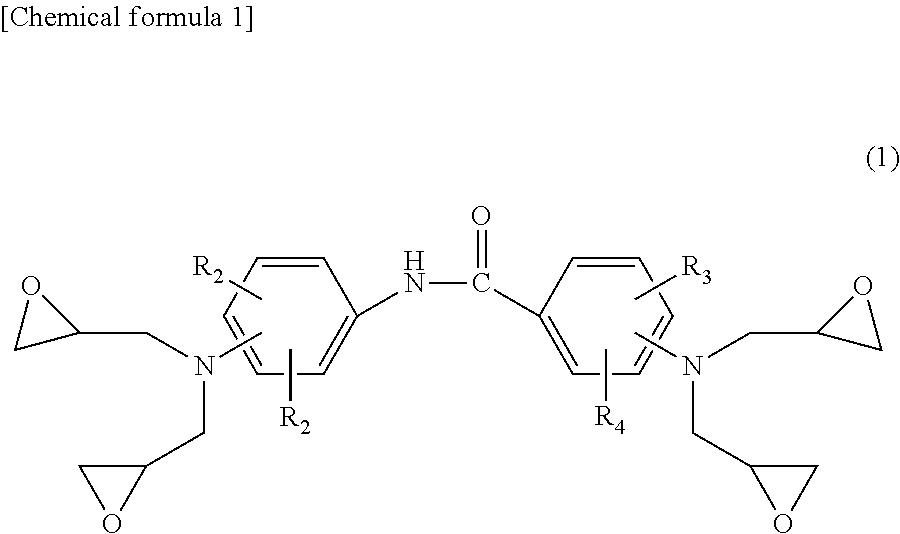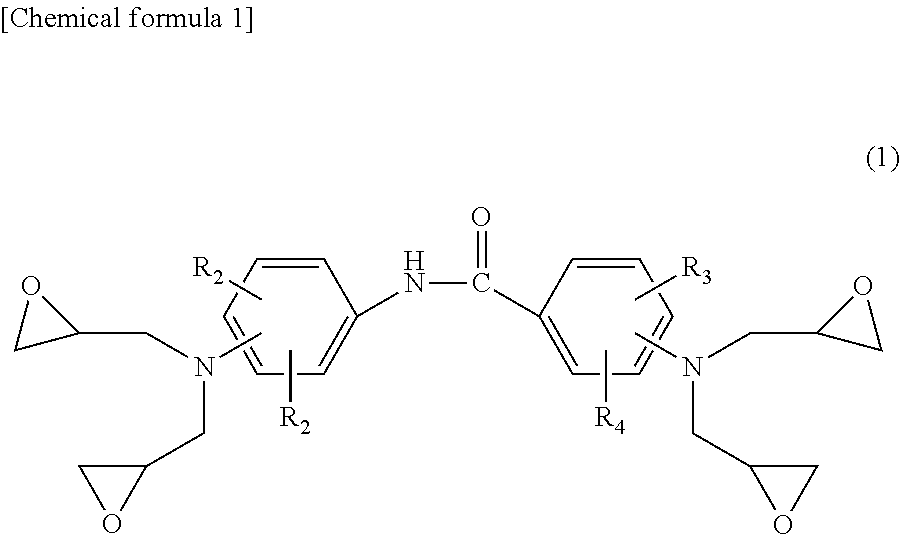Epoxy resin composition, prepreg, and carbon-fiber-reinforced composite material
a technology of epoxy resin and composite material, which is applied in the field of epoxy resin composition, prepreg, and carbon fiber reinforced composite material, can solve the problems of preventing the development of high strength, reducing the tensile strength and compression strength of the fiber at the same time, and reducing the tensile strength and compression strength. , to achieve the effect of high tensile strength, high flexural modulus, and high tensile strength
- Summary
- Abstract
- Description
- Claims
- Application Information
AI Technical Summary
Benefits of technology
Problems solved by technology
Method used
Image
Examples
example 1
[0102]Using a kneading apparatus, 70 parts by mass of tetraglycidyl-4,4′-diaminobenzanilide, 30 parts by mass of jER825, and 3 parts by mass Virantage (registered trademark) VW-10700RFP were kneaded at 160° C. for 2 hours and cooled to 70° C. after confirming complete dissolution of Virantage (registered trademark) VW-10700RFP by visual observation. Then, 34 parts by mass of 4,4′-DABAN was added, followed by kneading to provide an epoxy resin composition. Table 1 lists the components and proportions (figures in Table 1 are in parts by mass).
[0103]From the resulting epoxy resin composition, a cured epoxy resin was produced by the preparation method for a cured product of an epoxy resin composition described in (2) above. The flexural modulus and rubber-state elastic modulus of the resulting cured epoxy resin were measured by the measuring method for flexural modulus of cured epoxy resin described in (3) above and the measuring method for rubber-state elastic modulus of cured epoxy re...
examples 7-10
[0107]Except that the types and proportions of the epoxy resin and curing agent used were as shown in Table 1, the same procedure as in Example 1 was carried out to produce cured epoxy resin and prepreg and their flexural modulus, rubber-state elastic modulus, 0° tensile strength, and 0° compression strength were measured. Results are given in Table 1. In Examples 7 to 10, the rubber-state elastic modulus was low and the flexural modulus was high. As the blending quantity of tetraglycidyl-4,4′-diaminobenzanilide was decreased from 70 parts by mass to 40 parts by mass, the flexural modulus slightly decreased as compared to Examples 1 to 6, despite a high 0° tensile strength and a high 0° compression strength.
examples 16 and 17
[0109]Except that the types and proportions of the epoxy resin and curing agent used were as shown in Table 2, the same procedure as in Example 1 was carried out to produce cured epoxy resin and prepreg and their flexural modulus, rubber-state elastic modulus, 0° tensile strength, and 0° compression strength were measured. Results are given in Table 2. In Examples 16 and 17, the rubber-state elastic modulus was low and the flexural modulus was high. The 0° tensile strength and the 0° compression strength were both high. As tetraglycidyl-4,4′-diaminobenzanilide was replaced with tetraglycidyl-3,4′-diaminobenzanilide, the flexural modulus improved without suffering a significant change in rubber-state elastic modulus as compared to Examples 1 and 6. The 0° tensile strength and 0° compression strength both improved.
PUM
| Property | Measurement | Unit |
|---|---|---|
| rubber-state elastic modulus | aaaaa | aaaaa |
| flexural modulus | aaaaa | aaaaa |
| tensile strength | aaaaa | aaaaa |
Abstract
Description
Claims
Application Information
 Login to View More
Login to View More - R&D
- Intellectual Property
- Life Sciences
- Materials
- Tech Scout
- Unparalleled Data Quality
- Higher Quality Content
- 60% Fewer Hallucinations
Browse by: Latest US Patents, China's latest patents, Technical Efficacy Thesaurus, Application Domain, Technology Topic, Popular Technical Reports.
© 2025 PatSnap. All rights reserved.Legal|Privacy policy|Modern Slavery Act Transparency Statement|Sitemap|About US| Contact US: help@patsnap.com



